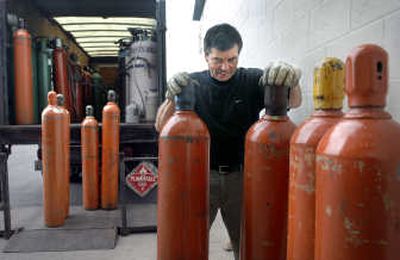Helium shortage has suppliers deflated

Karen Stokes drove to Yakima on Sunday just to pick up two tanks of helium.
The owner of Balloon Specialties and Jackie Lynn’s Flowers in Spokane, she uses the lighter-than-air gas to inflate festive balloons. When she recently called her distributor for a resupply, however, she learned it could be months before she would receive fresh tanks.
“We were holding our breath until we could get to Yakima yesterday,” she said.
Stokes is among local florists and other businesspeople feeling the effects of a global helium shortage. Helium – a byproduct of natural gas production – might best be known for causing high-pitched voices when inhaled, but it’s used in welding, MRI imaging and other industries.
While local medical companies say they haven’t been hit by deflated supplies, some regional distributors have juggled deliveries to smaller firms, like flower and party shops, to focus on medical and other contracts. Local suppliers attribute the tight market to increasing demand and global production shortfalls.
“It’s causing us to have to work with our clientele … to determine who’s going to get product and who doesn’t,” said Michael Sutley, vice president and general manager for Spokane-based Oxarc Inc., which serves 16 locations in three states.
The company late last month got word it would receive all of what it sold last year, Sutley said. That still doesn’t leave room for growth, he said.
“The ones who are going to suffer the most are like novelty helium use, which is mainly balloons,” said Shan Bush, president of A-L Compressed Gases Inc. in Spokane. “We’re trying to take care of everyone, but it’s not possible to have as much helium as you had last year.”
A 244-cubic-foot helium cylinder, which could fill about 1,000 balloons, could cost $60 to $90, depending on delivery charges and quantity, Sutley said.
Would-be party hosts may still be able to get their hands on helium, but they could face rising costs and limited supply. At Party Palace in Spokane, manager Dan Duncan said the business has absorbed increasing helium prices over the years. Supplied by Oxarc, the business recently increased its inflated-balloon prices by about 10 cents. It still rents helium tanks for $35 to $125, but it might be short of tanks at times, he said.
“Some weeks, we won’t be able to get certain sizes,” he said. “It is putting a little bit of a pinch on things, but we were warned that it would start happening.”
Most of the world’s supply comes from the U.S., Russia, Poland and Algeria and Qatar, according to the U.S. Bureau of Land Management, which sets prices for crude helium from government reserves.
While more helium sources are expected worldwide, the military is using a large quantity for laser systems, Sutley said.
“Until overseas plants are fully online and/or additional plants are built, we’re potentially facing additional supply disruptions, if not shortages,” a BLM official wrote in March.
Stokes’ supplier, A-L Compressed Gases, is receiving 60 percent of what it got last year, Bush said.
“It just finally caught up to us over here,” he said. “There’s just more use these days than there ever was.”
Some MRI machines use liquid helium to cool the magnets that generate their magnetic field. Last year, cryogenics, including MRI applications, comprised 28 percent of U.S. helium use, according to the BLM.
Spokane-based Inland Imaging hasn’t been affected, said Dennis Hake, chief marketing officer. Spokespeople for Deaconess and Sacred Heart medical centers also said they remain unaffected.
“It’s very equipment dependent, so we don’t see any challenges with service delivery as a result of that shortage,” Hake said.
Stokes was inflating balloon archways for the grand opening of the new Spokane Kohl’s store last week when she ran low on gas, she said. Balloons make up as much as 30 percent of her business, “so that can hurt a lot,” she said.
She’s willing to visit Yakima again, Stokes said, and she’s considering switching to a different supplier but paying $108 per tank – twice her current outlay.
Sutley, Oxarc vice president, said some car dealerships, restaurants and florists are cutting back or finding creative ways to cope, such as using more air or other gases to fill balloons or tying balloons to clear poles instead of relying on them floating. But Stokes said she’s not willing to cut quality by using less helium.
“I’m willing to wait till it kind of levels, which it will,” Stokes said.